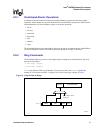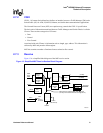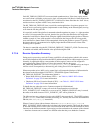
58 Hardware Reference Manual
Intel
®
IXP2800 Network Processor
Technical Description
Head, Tail, and Size are registers in the Scratchpad Unit. Head and Tail point to the actual ring data,
which is stored in the Scratchpad RAM. The count of how many entries are on the Ring is
determined by hardware using the Head and Tail. For each Ring in use, a region of Scratchpad
RAM must be reserved for the ring data.
Note: The reservation is by software convention. The hardware does not prevent other accesses to the
region of Scratchpad Memory used by the Ring. Also the regions of Scratchpad Memory allocated
to different Rings must not overlap.
Head points to the next address to be read on a get, and Tail points to the next address to be written
on a put. The size of each Ring is selectable from the following choices: 128, 256, 512, or 1024
32-bit words.
Note: The region of Scratchpad used for a Ring is naturally aligned to it size.
When the Ring is near full, it asserts an output signal, which is used as a state input to the
Microengines. They must use that signal to test (by doing Branch on Input State) for room on the
Ring before putting data onto it. There is a lag in time from a put instruction executing to the Full
signal being updated to reflect that put. To guarantee that a put will not overfill the ring there is a
bound on the number of Contexts and the number of 32-bit words per write based on the size of the
ring, as shown in Table 14. Each Context should test the Full signal, then do the put if not Full, and
then wait until the Context has been signaled that the data has been pulled before testing the Full
signal again.
An alternate usage method is to have Contexts allocate and deallocate entries from a shared count
variable, using the atomic subtract to allocate and atomic add to deallocate. In this case the
Full signal is not used.
Table 14. Ring Full Signal Use – Number of Contexts and Length versus Ring Size
Number of
Contexts
Ring Size
128 256 512 1024
1 16161616
2 16161616
4 8 16 16 16
8 4 12 16 16
16 2 6 14 16
2414916
3213715
40 Illegal 2 5 12
48 Illegal 2 4 10
64 Illegal 1 3 7
128 Illegal Illegal 1 3
NOTES:
1. Number in each table entry is the largest length that should be put. 16 is the largest length that a single put
instruction can generate.
2. Illegal -- With that number of Contexts, even a length of one could cause the Ring to overfill.


















